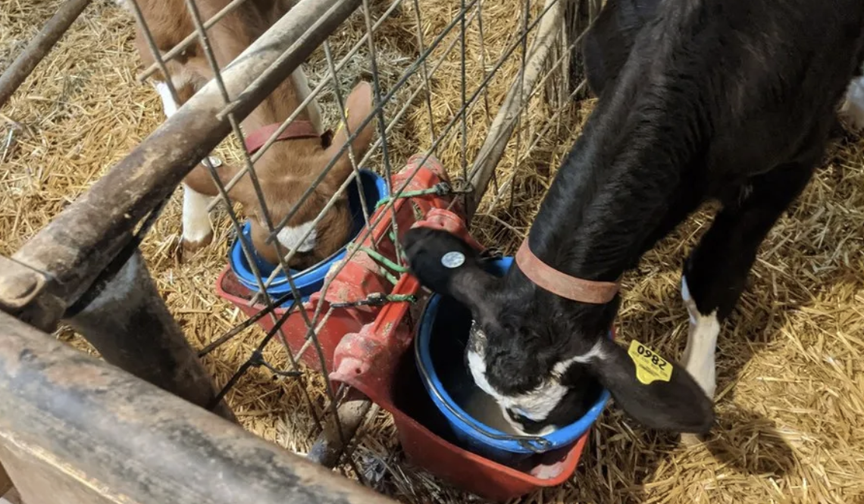
Feeding calves non-saleable milk can be a good economic decision for the dairy, but it is important to understand the risks.
Feeding wet calves waste milk from treated or high Somatic Cell Count (SCC) cows is a common practice. There are many advantages to feeding waste milk, also known as non-saleable milk. Keeping high SCC cows out of the bulk tank lowers the average SCC of the bulk tank and can help farmers receive a premium for high-quality milk. Milk from cows treated with antibiotics cannot be sold within the withdrawal period of that medication. Feeding this milk to calves gives it a use and reduces the money spent on milk replacer.
How does high SCC impact colostrum and waste milk?
The SCC level of the cow at dry off can negatively affect the cow, but it could also have implications for the calf it is carrying. One study showed that cows that dried off with subclinical mastitis were more likely to have stillborn calves (Antanaitis et al., 2022). Cows with high SCC at dry-off also have a higher risk of coming into the subsequent lactation with an elevated SCC. Research has shown that cows with high SCC at dry-off produce colostrum with lower IgG concentration (Gulliksen et al., 2008; Pasatorini et al., 2025), so it is essential to dry treat these cows. This would mainly affect calves if they were fed this lower-quality colostrum. Monitoring colostrum quality with a tool such as a BRIX Refractometer is critical for successful colostrum management. Low-quality colostrum should be replaced with high-quality colostrum or colostrum replacer. Mixing low-quality colostrum and colostrum replacer is possible, but it will not produce the desired IgG concentration.
What about waste milk coming from treated animals?
The most common disease that cows are treated for is mastitis, so it is safe to say that much of the high SCC waste milk fed to calves also contains antibiotics. While feeding this non-saleable milk to calves can be a good economic decision, there are some potential health concerns. Research has shown that feeding calves milk treated with antibiotics can increase antibiotic resistance in the calf (Foutz et al., 2018). The higher the concentration of antibiotics in the milk, the more resistant the gut bacteria become (Langford et al., 2003). Increasing antibiotic resistance in the calf can make treating that animal more difficult in the future. One example of this has been shown in a study that fed calves milk replacer with antibiotic residue to mimic non-saleable milk. This study showed that calves fed the milk replacer with antibiotic residue had more cases of scours (Flynn et al., 2025).
Reducing Bacteria in Waste Milk
Conclusions
Feeding calves non-saleable milk can be a good economic decision for the dairy, but it is important to understand the risks.
References
Antanaitis, R. V. Juozatiene, V. Jonike, W. Baumgartner, A. Paaaulauskas. 2022. Subclinical Mastitis Detected during the Late Gestation Period Can Increase the Risk of Stillbirth in Dairy Calves. Animals. 12:1394.
Armengol, R. and L. Fraile. 2016. Colostrum and milk pasteurization improve health status and decrease mortality in neonatal calves receiving appropriate colostrum ingestion. J. Dairy Sci. 99:4718-4725.
Aust, V., K. Knappstein, H. J. Kunz, J. Wallmann, and M. Kaske. 2012. Feeding untreated and pasteurized waste milk and bulk tank milk to calves: effects on calf performance, health status, and antibiotic resistance of fecal bacteria. Anim. Phys. Anim. Nutr. 97:1091-1103.
Butler, J. A., S. A. Sickles, C. J. Johanns, and R. F. Rosenbusch. 2000. Pasteurization of Discard Mycoplasma Mastitic Milk Used to Feed Calves: Thermal Effects on Various Mycoplasma. J. Dairy Sci. 83:2285-2288.
Flynn, A., W. Barton, C. McAloon, M. McFadden, F. Crispie, S. E. McPherson, G. Allendez, J. P. Murphy, C. G. McAloon, P. D. Cotter, and E. Kennedy. 2025. Effects of feeding a simulated waste milk on growth, health, fecal microbiota, and antibiotic resistance in dairy heifer calves. J. Dairy Sci. In press, Journal pre-proof.
Foutz, C. A., S. M. Godden, J. B. Bender, F. Diez-Gonzalez, M. Akhtar, and A. Vatulin. 2018. Exposure to antimicrobials through the milk diet or systemic therapy is associated with a transient increase in antimicrobial resistance in fecal Escherichia coli of dairy calves.
Godden, S. M., J. P. Fetrow, J. M. Feirtag, L. R. Green, and S. J. Wells. 2005. Economic analysis of feeding pasteurized non-saleable milk versus conventional milk replacer to dairy calves. J. Am. Vet. Med. Assoc. 226:1547-1554.
Gulliksen, S. M., K. I. Lie, L. Solverod, and O. Osteras. 2008. Risk Factors Associated with Colostrum Quality in Norwegian Dairy Cows. J. Dairy Sci. 91:704-712.
Langford, F. M., D. M. Weary, and L. Fisher. 2003. Antibiotic Resistance in Gut Bacteria from Dairy Calves: A Dose Response to the Level of Antibiotics Fed in Milk. J. Dairy Sci. 86:3963-3966.
Pastorini, M., N. Pomies, A. Meikle, and A. Mendoza. 2025. Transference of passive immunity and growth in dairy calves born to dams with high or low somatic cell counts at dry-off and fed colostrum from cows with high or low somatic cell counts at dry-off.





Be the first to comment